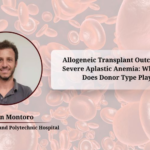
Editor’s Note: The 34th Annual Meeting of the Asian Pacific Association for the Study of the Liver (APASL 2025) concluded successfully on March 30. Following the events in Beijing (2010) and Shanghai (2017), this marked the third time that China hosted this prestigious regional academic congress, highlighting the country’s growing influence in liver disease research and clinical practice. This year’s theme, “Multidisciplinary Collaboration: Toward the Elimination and Cure of Liver Diseases,” brought together top experts from around the world to discuss cutting-edge developments in hepatology.Among the notable contributions, the research team led by Dr. Yinying Lu from the Fifth Medical Center of the PLA General Hospital presented several significant findings on liver cancer treatment. Two studies were selected for oral presentation, and several others were featured as poster sessions—drawing considerable attention. Hepatology Digest takes a closer look at some of these key achievements to share the voice of Chinese hepatology with the world.
Oral Presentations
Study 1
Retrospective Analysis of Efficacy Differences Between Lenvatinib and Sorafenib in Patients with Mid-to-Late Stage Hepatocellular Carcinoma Complicated Diabetes (APASL Abstract No. OP0072)
Diabetes is a major comorbidity of hepatocellular carcinoma (HCC) and can significantly impact both prognosis and the efficacy of targeted therapies. This study was the first to systematically compare the efficacy of first-line targeted therapies—sorafenib versus lenvatinib—in patients with advanced HCC and comorbid diabetes.
A retrospective review of data from 259 patients treated between 2018 and 2022 showed that among patients with diabetes, the median overall survival (OS) in the sorafenib group was 19.9 months, compared to 16.3 months in the lenvatinib group, with no statistically significant difference (aHR = 0.85).
Multivariate Cox regression analysis identified the albumin/ALT ratio as an independent protective factor (HR = 0.62), while elevated neutrophils, larger tumor size, and vascular invasion were independent risk factors (HR = 1.34–2.17). Subgroup analysis revealed a borderline OS benefit for diabetic patients treated with sorafenib (P = 0.052), whereas lenvatinib showed no survival difference in relation to diabetic status.
This study provides new evidence for personalized therapy: sorafenib is recommended for advanced HCC patients with poorly controlled diabetes. The findings offer valuable clinical guidance for optimizing treatment strategies in this patient population, though further prospective research is needed to explore the underlying metabolic interactions.
Study 2
Efficacy and Safety of Pembrolizumab and Lenvatinib in Combination with GEMOX via Different Administration Routes(HAIC vs intravenous) in Advanced Intrahepatic Cholangiocarcinoma: A Retrospective Analysis of Real-World Evidence (APASL Abstract No. OP0071)
This study retrospectively compared hepatic arterial infusion chemotherapy (HAIC) and intravenous infusion (IV) of GEMOX (gemcitabine + oxaliplatin) in combination with pembrolizumab and lenvatinib for treating advanced intrahepatic cholangiocarcinoma (ICC).
Results indicated that the HAIC group had improved overall survival compared to the IV group, while progression-free survival, tumor response, and treatment-related adverse events were comparable between the two groups.
Multivariate Cox regression identified both the route of GEMOX administration and the number of treatment cycles as independent predictors of progression-free survival. These results suggest that HAIC-based combination therapy may offer a survival advantage for patients with advanced ICC, though further prospective validation is warranted.
Poster Presentations
Study 1
Single-Cell RNA Sequencing for a Rare Case of Primary Biliary Cholangitis-Associated Hepatocellular Carcinoma Reveals a Distinct Immune Landscape and Potential Therapeutic Targets
(APASL Abstract No. PP0645)
Primary biliary cholangitis (PBC) is a chronic autoimmune cholestatic liver disease. While hepatocellular carcinoma (HCC) is a known complication in patients with PBC-related cirrhosis, the single-cell characteristics of such cases remain largely unclear—particularly in the context of cirrhosis.
This study is the first to conduct a combined single-cell transcriptomic analysis of peripheral blood, adjacent non-tumorous tissue, and tumor tissue from a 60-year-old female patient with PBC-related cirrhosis and concurrent HCC.
The analysis revealed pronounced immune and tumor cell heterogeneity. Notably, there was a stark contrast between the highly activated peripheral immune profile and the weak immune infiltration observed within the tumor microenvironment. This suggests that immune suppression or exclusion mechanisms within the tumor may need to be addressed in future treatments.
Furthermore, activation of the EGFR, GHR, and AMPK signaling pathways was identified within the tumor, offering important clues for developing targeted therapies.
These findings not only enhance our understanding of the mechanisms driving PBC progression to HCC but also lay the groundwork for personalized immunotherapy strategies in this rare and complex clinical context.
Study 2
Identification of Gut Microbiota and Bile Acid Metabolites Signatures for Predicting Response to Lenvatinib and Anti-PD-1 Combination Therapy in Hepatocellular Carcinoma
(APASL Abstract No. PP1039)
This study aimed to determine whether gut microbiota and metabolites can predict response to combination therapy in HCC patients. A total of 236 HCC patients receiving combination therapy were prospectively enrolled and divided into responder and non-responder groups based on treatment efficacy. Metagenomic sequencing and targeted metabolomic analysis were used to identify differential microbiota and metabolites. Random forest modeling was applied to select key features, construct ROC curves to differentiate the two groups, and validate the findings using public datasets.
Results showed significant differences in gut microbiota between responders and non-responders. Five microbial species, including Clostridium fessum, were identified as predictive markers, and the resulting ROC curve achieved an AUC of 0.84, with external validation confirming an AUC of 0.83. Targeted metabolomics identified GLCA-3-S, a bile acid metabolite, as a critical predictor. When combined with the identified microbial species, the predictive AUC rose to 0.93. These findings suggest that specific gut microbiota and bile acid metabolites may serve as potential predictive biomarkers for the clinical outcomes of lenvatinib combined with PD-1 inhibitors in advanced HCC, providing valuable insights for personalized treatment strategies.
Study 3
Weissella confusa inhibits Liver Cancer Lung Metastasis by suppressing the Secretion of Ursodeoxycholic Acid (UDCA)
(APASL Abstract No. PP0954)
This study investigated the role and mechanism of Weissella confusa and its related metabolite ursodeoxycholic acid (UDCA) in suppressing lung metastasis of liver cancer. Four-week-old Balb/c wild-type mice were divided into experimental and control groups (5 mice per group). All mice were first treated with broad-spectrum antibiotics via gavage for 4 weeks to eliminate gut microbiota, then injected with H22 hepatocellular carcinoma cells (5×10⁶ cells/mouse) via the tail vein to establish a lung metastasis model.
The experimental group received daily oral gavage of Weissella confusa (1×10⁹ CFU/mL, 200 μL), while the control group received the same volume of culture medium. After 4 weeks, the mice were sacrificed, and lung tissues were analyzed. Results showed a significant reduction in both lung weight/body weight ratio and lung nodule count in the experimental group (P<0.05), indicating that Weissella confusa inhibits liver cancer lung metastasis.
Targeted metabolomic analysis of lung tissue revealed significantly lower levels of UDCA in the experimental group (P<0.05), suggesting a possible role of UDCA in the metastatic process. To further confirm this, another group of mice injected with H22 cells received daily intraperitoneal injections of UDCA (10 mg/kg), while controls received PBS. After 4 weeks, mice in the UDCA group had significantly higher lung weight/body weight ratios and more lung nodules (P<0.05), indicating that UDCA may promote lung metastasis.
Statistical analysis used t-tests for continuous variables and chi-square tests for tumor incidence. Overall, the findings suggest that Weissella confusa suppresses lung metastasis of liver cancer by modulating UDCA levels.
Study 4 Patients with HBV Reactivation in Advanced Liver Cancer Have a Poorer Prognosis
(APASL Abstract No. EP0994)
Previous studies by this research group explored the effects of different systemic therapies on HBV reactivation in patients with unresectable hepatocellular carcinoma (uHCC). However, elderly patients have often been excluded from such research.
This study included 231 uHCC patients aged 75 years or older, who were categorized into reactivation and non-reactivation groups based on whether HBV reactivation occurred. The primary endpoint was overall survival (OS), and the secondary endpoint was progression-free survival (PFS).
Results indicated that HBV reactivation significantly impacted survival outcomes in elderly uHCC patients, often leading to tumor progression and influencing the effectiveness of systemic therapies.
This is the first study to focus specifically on elderly patients—a population typically underrepresented in clinical trials—and offers important guidance for treatment decision-making in this vulnerable group.
Study 5
Efficacy and Safety of Regorafenib vs. Regorafenib Combined with PD-1 Inhibitors as a Second-line Therapy in Patients with Advanced Hepatocellular Carcinoma: A Retrospective Analysis of Real-World Evidence
(APASL Abstract No. PP1069)
There is currently no universally accepted second-line therapy for HCC patients who fail first-line treatment. The research team previously reported that combining regorafenib with PD-1 inhibitors in second-line treatment yielded better survival outcomes than regorafenib alone.
This extended follow-up study, with data over a 5-year period, compared the efficacy of regorafenib plus PD-1 inhibitors versus regorafenib monotherapy in patients with advanced HCC.
Findings revealed that the combination therapy group had superior outcomes in terms of objective response rate (ORR), disease control rate (DCR), median progression-free survival (mPFS), and median overall survival (mOS).
The incidence of treatment-related adverse events (TRAEs), including grade 3/4 events, was similar between the two groups. These results support early implementation of regorafenib plus PD-1 inhibitors as a second-line treatment option to improve clinical benefits for patients.
Study 6
Efficacy and safety in Advanced Cholangiocarcinoma Using different doses of Lenvatinib Combined with PD-1 and GEMOX: A Retrospective Analysis of Real-World Evidence (APASL Abstract No. PP1007)
Immune checkpoint inhibitors combined with chemotherapy have become the standard first-line treatment for advanced cholangiocarcinoma (CCA). At the same time, other combination therapies—especially those involving targeted agents—are being actively explored.
This prospective study enrolled 33 histologically confirmed patients with advanced CCA who received first-line therapy with a PD-1 inhibitor, lenvatinib, and the GEMOX regimen (gemcitabine plus oxaliplatin). Patients were divided into two groups: Group A (17 patients) received the standard dose of lenvatinib, while Group B (16 patients) received a reduced dose. Treatment efficacy was assessed using RECIST v1.1 criteria, and safety was evaluated according to CTCAE v5.0.
The overall objective response rate (ORR) and disease control rate (DCR) among all patients were 48% and 84%, respectively. In Group A, the ORR was 35.2% and DCR was 82.3%; in Group B, the ORR reached 62.5% and DCR 87.5%. Moreover, patients in Group B experienced fewer treatment-related adverse events (AEs) and serious adverse events (SAEs) compared to those in Group A.
These findings suggest that the combination of pembrolizumab, lenvatinib, and GEMOX represents a promising first-line therapy for patients with advanced CCA. Notably, a reduced dose of lenvatinib may offer a more favorable safety profile without compromising treatment efficacy.


